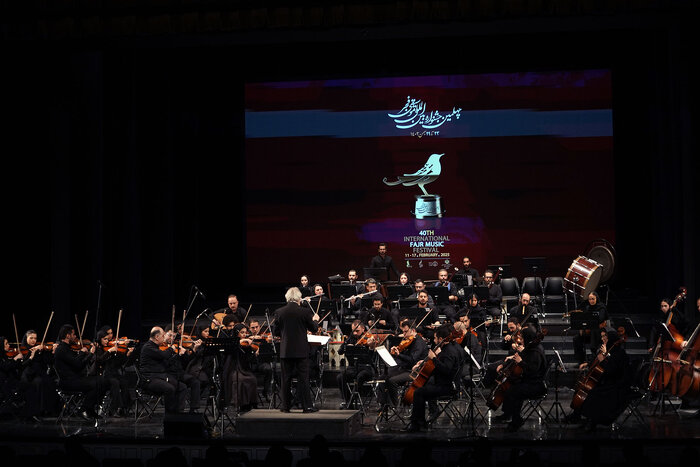
On the evening of February 12, 2025, the National Orchestra of Iran took the stage at Vahdat Hall as the first official performance of the 40th Fajr Music Festival. However, the concert suffered from rhythmic inconsistencies, lack of cohesion, and technical shortcomings, all amplified by a nearly empty concert hall—marking an underwhelming start to the hall’s festival programming.
The concert featured works by renowned Iranian masters such as Abolhasan Saba, Aminollah Rashidi, Hossein Dehlavi, and others, conducted by Homayoun Rahimian.
From the very first piece, intonation issues in the strings were noticeable, with passages that lacked cohesion. Offbeat entrances and rhythmic instability were evident from the start and persisted until the middle of the concert. Although this performance showed slight improvement compared to past concerts, rhythmic coherence remains one of the National Orchestra’s major ongoing issues. Despite ongoing efforts, the ensemble has yet to achieve satisfactory rhythmic alignment, which continues to be a serious challenge.
The second piece, Polka by Darvish Khan, arranged for orchestra, was performed with a sense of liveliness and energy. Its brisk tempo and dynamic beat brought a refreshing change in mood. In certain passages—particularly within the string section—the performance showed some level of coordination, contributing to an upbeat atmosphere. Still, the orchestra demonstrated that further cohesion was needed. Some entries remained uncoordinated, and occasional rhythmic instability made it clear that full alignment across the sections was not achieved. This issue, evident in other pieces as well, directly impacted the emotional and musical expression conveyed to the audience. In orchestral music, quality is not only about individual skill but the synergy and unity of the ensemble—something that faltered during climactic moments of this concert.
Later in the program, the piece Shushtari, featuring a violin solo by Amir Nazari, was performed. However, there was a clear lack of synchronization between the soloist and the orchestra. From the outset, the solo violin seemed ahead of the ensemble, and this timing issue only worsened as the piece progressed. Additionally, the soloist struggled with notable rhythmic inconsistencies, affecting the overall cohesion. Tonally, the performance lacked clarity and precision, failing to deliver a clean and unified sound. Overall, this section fell short both technically and in terms of coordination.
From the sixth piece onward, there was a noticeable improvement in the orchestra’s cohesion and rhythm. This positive shift was evident both in tempo and in ensemble unity. The second half of the program, featuring faster-paced works, was performed with greater precision. Notably, the tambourine player contributed significantly to the orchestra’s rhythmic integrity through well-timed and accurate playing, which helped elevate the performance. It’s worth noting that these later pieces posed fewer technical and rhythmic challenges, which likely contributed to the improved execution. Nevertheless, this portion of the concert was more energetic and better performed.
The final piece, Be Zendan by Abolhasan Saba, received a relatively strong performance. The orchestra showed acceptable levels of coordination and musical expression. However, the performance could have benefited from more dynamic variation. A more detailed approach to changes in volume and intensity (dynamics) would have added color and helped avoid monotony in certain passages. Still, the piece was performed with relative cohesion and served as a fitting conclusion to the concert.
In summary, it was evident that the National Orchestra of Iran has made some progress in addressing previous rhythmic issues, but many of these problems remain persistent. In more complex pieces, the ensemble frequently lost cohesion and failed to deliver a unified performance. This underscores that, despite some improvement, the orchestra continues to struggle with foundational issues—particularly when tackling works requiring high rhythmic accuracy and coordination. These weaknesses not only diminished the overall quality but also raised the familiar question: how can the National Orchestra of Iran, after years of operation, still face such basic performance challenges?
The concert was held in a nearly empty hall—once again highlighting the Fajr Festival’s serious shortcomings in advertising and audience outreach. There still appears to be no effective planning to attract audiences or generate enthusiasm for the event.
Contrary to expectations, the festival’s opening concert at Vahdat Hall lasted only an hour, whereas at least 90 minutes had been anticipated. One major criticism was the absence of a printed concert brochure. The concert repertoire was also not formally published in advance—an odd and unprofessional move for an orchestral performance.
For classical and orchestral music audiences, knowing the concert program ahead of time is essential, as it plays a major role in deciding whether to attend. Unlike popular concerts, where audiences may attend simply to enjoy live music, in classical performances, knowledge of the repertoire is crucial. Many attendees base their decisions on specific composers, musical styles, or even particular arrangements of a piece.
Failure to inform audiences about the program not only disrupts planning but signals a disregard for professional standards in orchestral music. Internationally, publishing the repertoire and providing a concert brochure is standard practice. Unfortunately, these basic principles were ignored in this concert. Without advance notice of the repertoire, attending such a concert feels like buying a watermelon without seeing the inside—a gamble that could deter audiences from future programs.
It is hoped that future iterations of the festival will address these shortcomings, and that organizers will place greater emphasis on proper communication and adherence to professional performance standards.
Written By Farid Parish
